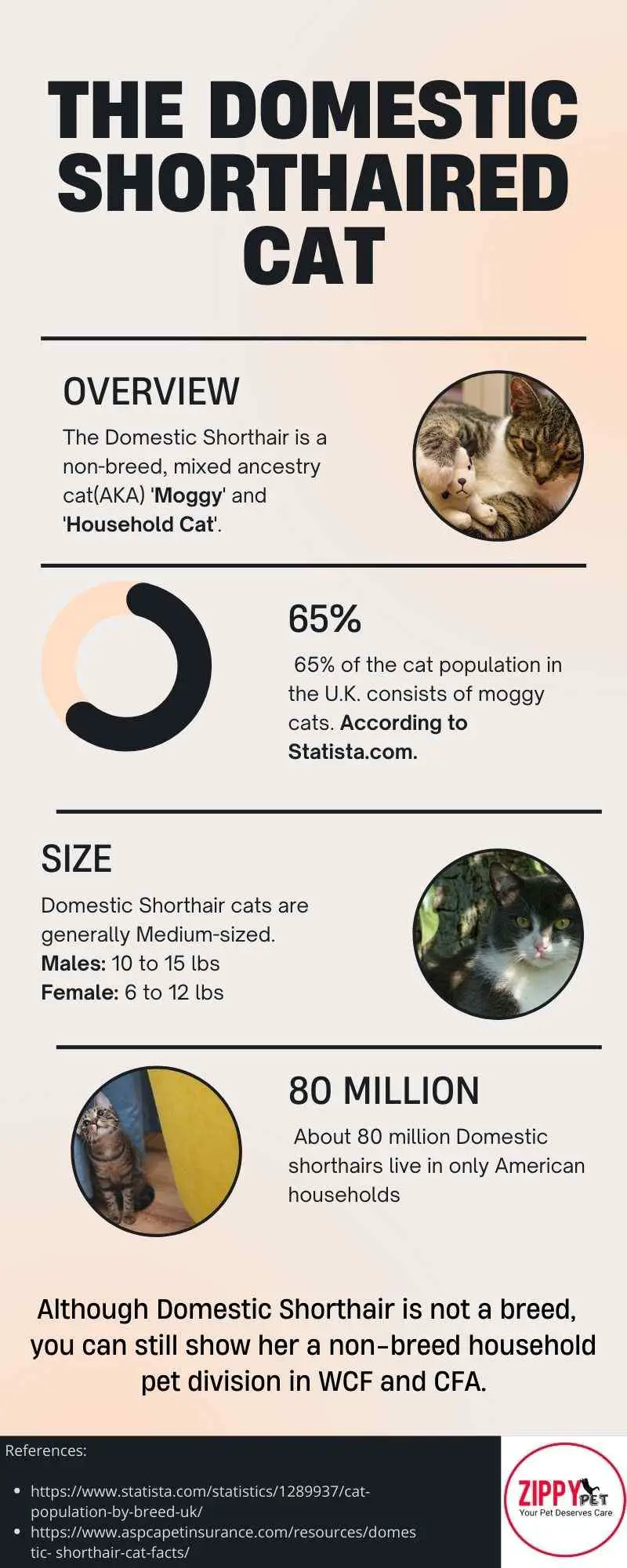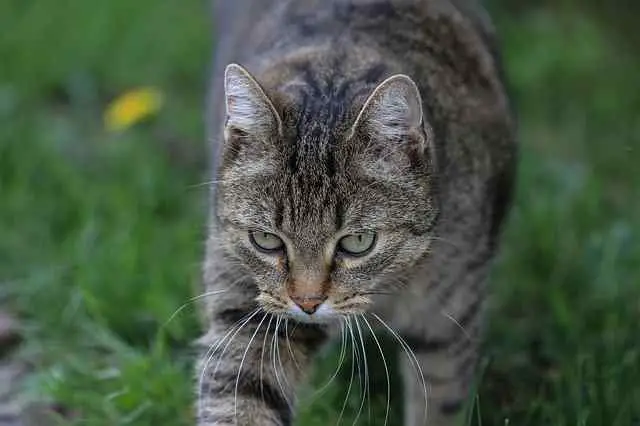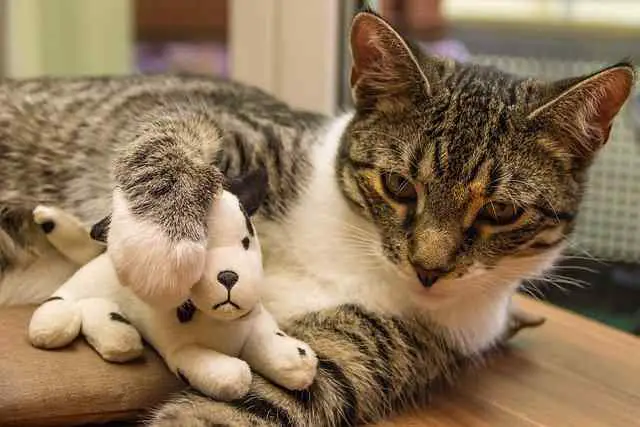- Top 10 Cat Names - March 4, 2024
- American Bobtail Cat Breed- Profile and Facts - July 8, 2023
- Black Cat Names 2023- With Meanings - June 28, 2023
Posted on March 8, 2022
The ‘Domestic Short-haired Cat’ is also known as ‘moggy’ and ‘mutt of the cat world’.
Domestic Cats (both short-haired and longhaired) are the most common cats in the entire cat population. According to the American Society for the Prevention of Cruelty to Animals ASPCA, about 80 million Domestic shorthairs live in only American households.
The statistics are no different in the United Kingdom too. A 2021’s survey disclosed that 65% of the cat population in the U.K. consists of moggy cats.
These cats show a range of colours, personalities, characteristics and traits. And have a low risk of developing serious health issues.
So if you are planning to buy or adopt a new family member then this article is for you.
Note* In this blog post I’ll often use an abbreviation DMS for ‘Domestic Short-haired’.
Domestic Short-haired Cat Facts Inforgraphic

Quick Information Table
| Other Names | Alley Cat, House Cat | Hair Type | Shorthair |
| NickNames | Moggy, Mutt | Life Expectancy | 12 to 15 years |
| Cat Association Recognition | FIFe, WCF and CFA(under non-breed household pet division) | Possible Health Issues | Obesity, joint pain, liver and kidney problems, diabetes and heart diseases. |
| Size | Medium-sized. Male between 10 to 15 lbs Female 6 to 12 lbs | Colour | Solid, tabby, bicolour, tricolour, calico and more. |
| Shedding | Low | Eye colour | Green, hazel, blue, brown, gold and two-colour |
| Hypoallergenic | No | Grooming needs | Low |
What is a Domestic Shorthair Cat?
Domestic short-haired is a non-breed mixed-ancestry cat with a medium-sized body. They exhibit a large array of colours and patterns. Since the American Shorthair breed was developed by domestic shorthair, both of them look much alike. But there is a huge difference. American Shorthair is a recognised breed while the Domestic Short-haired is not.
As you know, these cats are the result of mixed ancestry there are great variations found in their genetic makeup. As a result, they are a lot different from each other in terms of size, colours, personality and characteristics.
For example, Domestic Shorthaired cats that belong to Asia, generally have smaller sizes, sleek and lighter bodies. European and American DSH on the other hand has larger and heavier bodies.
Irrespective of so many differences there are some common characteristics shared by almost all Domestic Short-haired Cats such as—they all have muscular bodies, medium-length tails, rounded heads and paws.
Some common names of Domestic Short-haired cats are ‘ Alley cats’ and ‘ House Cats’. People also call them ‘moggy’/ot ‘mutt’ with love.
History
The exact origin of Domestic Shorthaired cats is unknown. However, there exists a widely accepted theory. According to a common belief, the Domestic Short-haired cats were first domesticated in Egypt around 2000 BC. When Europeans explored the new lands they came back with cats. That’s how cats from Africa entered Europe.
During the 1600s when Europeans went to explore America(known as the New World then) they put cats on the job to protect the cargo from rats and mice. So, these cats went on a pilgrimage from Europe to America.
Later, those who decided to settle down in America allowed the cats to live in their granaries and barnyards to help them control rodent populations in exchange for food and shelter. Gradually these cats earned the name ‘Working Cats’.
In 1966, the Cat Fanciers Associations of America fixed some strict standards and renamed the cats as American Shorthair.
However, the cats which do not fit these standards are still known as Domestic Short-hair.
Size

As said above Domestic Shorthaired varies a lot in size and body type. In general, they are medium-sized cats. Male cats can reach the weight of more or less 15 pounds whereas female DMS cats have smaller bodies. The average weight of a female domestic shorthaired cat can fall anywhere between 8 to 12 pounds.
Colours
The Domestic Short-haired cats show a myriad of colours and patterns. They can have solid colours including but not limited to such as white, black, brown, chocolate, and grey. Bi-colour and tricolour Domestic Shorthaired Cats can easily be seen anywhere. Similarly, they also show some typical patterns like tabby or calico.
Like their coats’ colour, the colour of their iris also varies from cat to cat. A DMS cat can have blue, brown, green, hazel, gold and even two different colour eyes.
You May Like to Read: White Cats with Blue Eyes
Personality

Like their colourful coats and variety of sizes, they exhibit a wide spectrum of personalities too. You’ll be surprised to see how much the two Domestic Shorthaired differ from each other in nature habits and socialisation.
One DMS cat could be reserved, calm, shy and easy-going while the other could be quirky, vocal, friendly, adventurous as well as aggressive.
Due to their muscular body, superb energy and outstanding agility, many Domestic Short-haired cats are a threat to small creatures such as birds, squirrels and rats, therefore, keeping them indoors is the best for them and the other animals.
Since they have varied personalities, the confident and friendly cats love to curl up in your lap or demand a petting session anytime. On the contrary, the shy cats just like to be in your company but by maintaining a distance.
The same variation is visible in their behaviour when it comes to interacting with strangers and new pets. Confident Domestic Shorthaired Cats waste no time in approaching and welcoming the guests. While the shy cats may hide in their favourite place, they stay there until the uninvited guests go out of their territory. LOL.
Official Acceptance by Cat Registries
DMS cat is not a breed so it is not accepted by any of the Cat Registry under the pedigree cats category.
Yet, don’t be disheartened. You can still show your cat in a non-breed household pet division. Few cat fanciers associations that provide this opportunity are Fédération Internationale Féline (FIFe), World Cat Federation (WCF) and Cat Fanciers Association (CFA).
Health and Lifespan
Domestic Shorthair Cats are pretty healthy cats and usually live a healthy and longer life. Generally, the average lifespan of a Domestic Short-haired cat is more or less 12 to 15 years. But this period may vary depending on the health condition of a particular cat.
Some DMS cats may develop health issues if not taken care of properly. The health problems that are common in DMS cats are—.
- Kidney, liver, and heart disease
- Obesity
- Diabetes
- Joint pain
If your cat has some health issues or you have observed some sudden changes in her behaviour then I advise you to visit a veterinarian and let her be examined thoroughly.
Shedding
Being a short-haired cat they neither grow longer and thicker hair before winter nor shed longer hair before summer so their overall shedding tendency is pretty low. Unless they are suffering from disease or malnutrition.
If your DMS cat is shedding a lot then the first step is to visit a vet. Secondly, you need to take care of her diet and grooming needs.
Care
Yes, keeping a Domestic Shorthair Cat instead of a pure breed allows you to enjoy economies of time, effort and money. But it doesn’t mean that they don’t need care, vaccination and regular grooming.
Let’s face it! You still need to take care of the diet, wellness of your coat and prevent dangers even if you have a DMS cat. Here are a few tips to give good care to your moggy.
- Feed her with good quality nutritious food preferably wet food in case she’s not underweight or you are specifically instructed by your veterinarian to feeding her with dry food.
- Visit a veterinarian at least once in 6 months to ensure that everything is going well both inside and outside her body. Also, make sure that she has taken all the mandatory vaccinations. Your vet will tell you more about these in detail.
- Take care of her grooming needs. Brush her once on alternate if not daily to keep her coat free from dust, lice, fallen hair, dead skin cells and throat from the creepy hairballs.
- Make sure that she has enough cat essentials to satisfy her instincts. Some must-to have cat essentials are cat beds, litter box, litter, tree, and carrier.
- Keep her indoors. Keep her indoors. One more time, keep her indoors. Believe me, it’s for her well-being and for the well being of other small lives outside the door. And, yes, It’s not cruel! Indoors cats usually live a longer and healthier life as compared to outdoor cats in general.
- Keeping her indoors doesn’t mean that she can’t outside at all. Walking with your cat by putting her on a harness and leash is not bad. In fact, it’s recommended. However, you should not force her to do that. Do it only if she likes it.
Are Domestic Short-haired Cats Good Pets?
Yes, absolutely. Domestic shorthaired cats are cute, less demanding, usually independent cats. They also love to enjoy play and can learn new tricks with proper training.
Most importantly a lot of DMS cats out there are waiting for someone to adopt them. Also, they have all the rights to have nutritious food, proper housing and essentials to satisfy their instincts just like a pedigree cat. In my opinion, adopting a cat from an animal shelter is a far better idea than buying an expensive breed cat.
So, Are You Adopting a Domestic Shorthaired Cat?
So, that was all about the Moggy. After knowing so much about the Domestic Short-haired cat it’s possible that now you love her more than you do before reading this post. I hope that you liked the article. If you liked it then let me know in the comment section. If you still have questions then you may ask me in the comments or you can mail me directly here’s my email admin@zippypet.in. With, that said, I wrap up this post and put a final full stop. Thanks for reading.
“Keep Loving the Moggy”